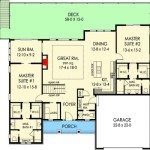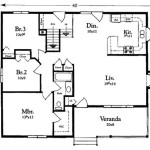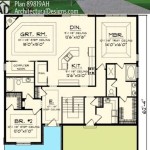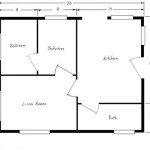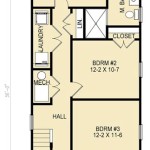4 Bedroom House Plans: Free Resources and Design Considerations
Securing a functional and aesthetically pleasing home design is often the first step in the home-building process. For many, the ideal family home includes four bedrooms, providing ample space for residents and guests. While professional architectural services offer tailored solutions, accessing free 4 bedroom house plans can be a cost-effective starting point, offering a valuable foundation for customization and personal adaptation.
This article explores the availability of free 4 bedroom house plans, examining the various online resources and design considerations necessary to ensure a successful building project. It highlights practical elements to examine within the plans, emphasizing the importance of verifying code compliance and adapting the design to specific site conditions and individual needs.
Evaluating Online Resources for Free House Plans
The internet offers a plethora of websites claiming to provide free house plans, including designs suitable for 4-bedroom homes. However, the quality and usability of these plans vary significantly. It is crucial to exercise caution and critical evaluation when selecting a plan from a free online source. Several reputable websites offer a selection of basic floor plans that, while not fully comprehensive architectural drawings, can serve as inspiration or a preliminary blueprint.
When searching for free house plans, consider the following:
Credibility of the Source: Prioritize websites affiliated with established architectural firms, construction companies, or home design publications. These sources are more likely to provide plans developed by qualified professionals, even if offered at no cost. Look for information about the plan's creator and their qualifications. Avoid sites with questionable origins or those lacking contact information.
Level of Detail: Free plans typically offer basic floor layouts and elevations. They may not include detailed construction drawings, structural engineering details, or mechanical, electrical, and plumbing (MEP) specifications. Understand the limitations of the free plans and anticipate the need for additional professional services to develop a complete set of construction documents.
Copyright and Usage Rights: Before using any free plan, carefully review the terms of use and copyright information. Some plans may be offered for personal use only and may not be modified or used for commercial projects without permission. Ensure compliance with all copyright restrictions to avoid legal issues.
Plan Format and Accessibility: Assess the format in which the plan is available. Common formats include PDF, DWG (AutoCAD), and image files. PDF files are easily accessible and printable, while DWG files allow for digital editing and modification using CAD software. Choose a format compatible with your skill level and available software.
User Reviews and Testimonials: If available, read user reviews or testimonials regarding the quality and accuracy of the plans. This can provide valuable insights into potential issues or limitations.
Some websites may require registration or subscription to access their free plan library. Exercise caution when providing personal information and review the website's privacy policy to understand how your data will be used.
Examples of resources include government sites dedicated to affordable housing, which sometimes offer example plans, and sites dedicated to sustainable or energy-efficient home designs. These resources often prioritize functionality and cost-effectiveness, providing a practical starting point for a 4-bedroom home design.
Essential Design Considerations for 4 Bedroom House Plans
Regardless of the source, adapting a free 4 bedroom house plan to individual needs and site conditions requires careful consideration of several key design elements. These elements directly impact the functionality, comfort, and overall cost-effectiveness of the home.
Floor Plan Layout and Functionality: The floor plan should prioritize efficient circulation, adequate room sizes, and a logical arrangement of spaces. Consider the relationships between different areas, such as the kitchen, dining room, and living room. Ensure sufficient space for furniture placement and traffic flow. In a 4-bedroom home, carefully consider the placement of bedrooms relative to living areas to minimize noise transmission. Different floor plan styles exist, such as ranch-style, two-story, or split-level, each with its own advantages and disadvantages, based on lot size and personal preferences.
Bedroom Size and Configuration: Determine the desired size and configuration of each bedroom. A master bedroom typically includes an en-suite bathroom and walk-in closet. The remaining bedrooms can be smaller and share a common bathroom. Consider the age and needs of the occupants when planning bedroom sizes and layouts. Ensure adequate closet space in each bedroom.
Bathroom Placement and Fixtures: The number and placement of bathrooms are crucial in a 4-bedroom home. A minimum of two full bathrooms is generally recommended, with a third bathroom being desirable for larger families. Consider placing a half-bathroom (powder room) near the living area for guests. Select appropriate bathroom fixtures, such as toilets, sinks, showers, and bathtubs, based on budget and personal preferences. Ensure adequate ventilation in each bathroom to prevent moisture buildup.
Kitchen Design and Functionality: The kitchen is the heart of the home and should be designed for both functionality and aesthetics. Consider the placement of appliances, countertops, and storage areas to create an efficient and user-friendly workspace. A kitchen island can provide additional countertop space and seating. Ensure adequate lighting and ventilation in the kitchen.
Living and Dining Areas: The living and dining areas should be designed to accommodate both everyday living and entertaining. Consider the size and shape of these spaces, as well as the placement of furniture and entertainment systems. Natural light and views can enhance the ambiance of these areas. Plan for adequate seating and dining space based on the size of the family and anticipated guest count.
Entrance and Foyer: The home's entrance should be welcoming and functional. Consider the size and layout of the foyer, as well as the placement of coat racks, benches, and storage areas. A well-designed entrance can create a positive first impression and provide a practical space for greeting guests.
Laundry Room and Storage: Include a dedicated laundry room with sufficient space for a washer, dryer, and ironing board. Plan for adequate storage space throughout the home, including closets, cabinets, and shelving. Consider adding a pantry to the kitchen for food storage.
Outdoor Spaces: Consider incorporating outdoor spaces into the design, such as a patio, deck, or porch. These spaces can extend the living area and provide opportunities for outdoor relaxation and entertainment. Ensure that outdoor spaces are accessible from the interior of the home. Consider the orientation of the home to maximize natural light and views from outdoor spaces.
Accessibility Considerations: Consider incorporating accessibility features into the design, such as wider doorways, grab bars in bathrooms, and ramps instead of steps. These features can make the home more accessible for individuals with disabilities or mobility limitations.
Adaptation and Code Compliance
Free house plans are rarely construction-ready. They typically require significant adaptation to meet local building codes, site-specific conditions, and individual lifestyle needs. Working with a qualified architect or structural engineer is essential to ensure compliance and structural integrity.
Local Building Codes: Building codes vary by location and dictate minimum standards for safety, health, and structural integrity. An architect or engineer can review the free plan and make necessary modifications to comply with local codes. This includes aspects like foundation requirements, framing specifications, electrical wiring, plumbing systems, and fire safety measures.
Site-Specific Considerations: The plan must be adapted to the specific characteristics of the building site. This includes factors such as lot size, topography, soil conditions, and local climate. A site survey and geotechnical investigation may be necessary to assess these conditions. The foundation design, drainage systems, and landscaping must be tailored to the site to ensure stability and prevent water damage.
Structural Engineering: A structural engineer will review the plan and perform calculations to ensure that the home's structure is capable of withstanding anticipated loads, such as wind, snow, and seismic activity. The engineer will specify the size and type of structural members, such as beams, columns, and walls, to guarantee structural integrity. This is especially important if making significant modifications to the original plan.
Mechanical, Electrical, and Plumbing (MEP) Systems: The MEP systems must be designed to meet the home's energy efficiency and comfort requirements. An MEP engineer can design the heating, ventilation, and air conditioning (HVAC) system, electrical wiring, and plumbing systems to ensure optimal performance and safety. The MEP design should comply with local energy codes and regulations.
Energy Efficiency: Incorporate energy-efficient features into the design to reduce energy consumption and lower utility bills. This includes features such as high-performance windows, insulation, and HVAC systems. Consider incorporating renewable energy sources, such as solar panels or geothermal heating, to further reduce energy costs. Orientation of the house to maximize solar gain in winter and minimize it in summer is also crucial.
Permitting Process: Obtain the necessary building permits from local authorities before starting construction. The permitting process typically requires submitting a complete set of construction documents, including architectural plans, structural engineering calculations, and MEP drawings. An architect or engineer can assist with preparing the necessary documents and navigating the permitting process.
Adapting a free 4 bedroom house plan to meet specific needs and code requirements requires a collaborative effort between the homeowner, architect, engineer, and builder. By carefully considering these factors, it is possible to create a safe, functional, and aesthetically pleasing home that meets the family's needs and budget.

4 Bedroom Small Plot Home Design With Free Plan

House Plans 12x12 Meter 4 Bedrooms Hip Roof 40x40 Feet Samhouseplans

4 Bedroom Stunning Mix Designed Modern Home In 2997sqft Free Plan

60x30 House 4 Bedroom 3 Bath 1 800 Sq Ft Floor Plan Instant Model 2

Middle East Style Four Bedroom House Plan Free Gound Floor Dwg Net Cad Blocks And Plans

4 Bedroom House Plan Examples

4 X 2 House Plans Bed Bathroom Celebration

Modern 4 Bedroom House Plan For Nethouseplans

Craftsman Plan 2 348 Square Feet 4 Bedrooms 3 Bathrooms 5995 00021

Free Home Plans



